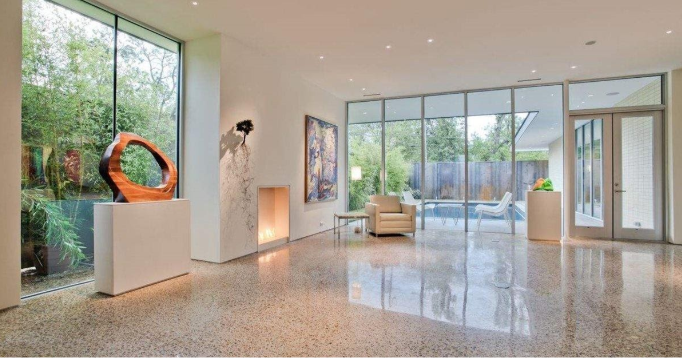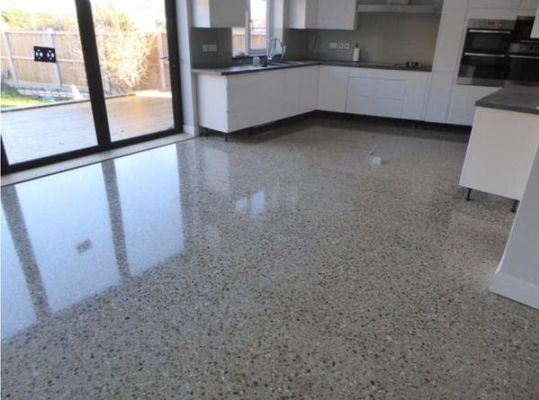Polished Floors
Polished Floors
What Is Concrete?
Concrete is a mixture of cement, air, water, sand, and gravel, with the typical concrete mix is made up of roughly 10% cement, 20% air and water, 30% sand, and 40% gravel.
Although the terms cement and concrete often are used interchangeably, cement is actually an ingredient of concrete. Concrete is a mixture of aggregates and paste. The aggregates are sand and gravel or crushed stone; the paste is water and portland cement.
Not surprisingly, designers and artists have discovered that concrete is a living material that responds to their hands and then goes on from this responsive plastic state to become a hardened, permanent, complete expression of the artist's intent. These features and concrete's versatility of appearance as a building material, compatibility for use with diverse other structural materials, and the many techniques by which it can be used at the job site add up to an impressive array of assets. What other building material exists that we can pump, pour, cast, spray, trowel, mold, form, and carve? Our ability to adjust the physical characteristics of concrete to a host of application techniques is a further reason why the material has found its way into such an assortment of uses.
Polished Floors
Polished concrete is a multi-step process where a concrete floor is mechanically ground, honed, and polished with bonded abrasives in order to cut a concrete floor's surface. It is then refined with each cut in order to achieve a specified level of appearance.
This process also includes the use of a penetrant chemical known as a hardener. The concrete densifier/hardener penetrates into the concrete and creates a chemical reaction to help harden and dust-proof the surface. During concrete polishing, the surface is processed through a series of steps (in general a minimum of four grinding steps of processing is considered polished concrete) utilizing progressively finer grinding tools. The grinding tools are progressive grits of industrial diamonds in a bonded material such as metal/hybrid/resin often referred to as diamond polishing pads. Polished concrete is a "green" flooring system and LEED approved. Concrete is not considered polished before 1600 grit, and it is normally finished to either 1600 or 3000+ grit level. Dyes designed for concrete polishing are often applied to add color to polished concrete as well as other options such as scoring, creating radial lines, grids, bands, borders, and other designs. Any grinding under 1600 grit is considered a honed floor.
Polished concrete floors are low-maintenance as they are durable and easy to clean. Its high coefficient of friction can make it non-slippery. Polished concrete reduces dust mite and allergen problems and does not support mold growth. Anecdotal evidence suggests that highly reflective polished concrete reduces lighting needs and can improve natural lighting. Polished concrete flooring is hard wearing and will not chip or dent like softer surfaces such as timber and tiles. Polished concrete is easily maintained with the use of clean water or a neutral balance pH cleaner. There are also many cleaners designed for the proper maintenance of polished concrete available. There is never a need for wax to be added as it will only dull the finish. A concrete floor that has been hardened and polished will have an extremely long life expectancy compared to other flooring types. Concrete structures can have a life span of more than 100 years.
To learn more about polished concrete floors or to get started on your project, contact us at Crete Vision Inc. today!


